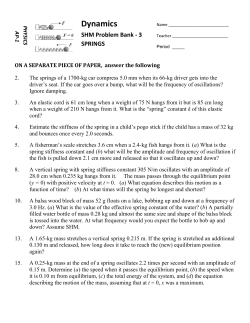
University of Mannheim Problem Set II: Public Goods
University of Mannheim
E557 Master Public Economics
Problem Set II: Public Goods
Spring 2015
Exercise 1: Hindriks and Myles, 2006. 5.13
Consider two consumers (1, 2), each with income M to allocate between two goods. Good 1
provides 1 unit consumption to its purchaser and 0 ≤ α ≤ 1 units of consumption of good 1
to the other consumer. Each consumer i has the utility function U i = log(xi1 ) + xi2 , xi1 is the
consumption of good 1 and xi2 is consumption of good 2.
1. Provide an interpretation of α.
2. Suppose that good 2 is a private good. Find the symmetric Nash equilibrium levels of
consumption when both goods have a price of 1.
3. By maximizing the sum of utilities, show that the equilibrium is Pareto-efficient only if
α = 0.
4. Now suppose that good 2 also provides 1 unit of consumption to its purchaser and α
units of consumption to the other consumer. Find the symmetric Nash equilibrium. Is
it efficient?
1
Exercise 2
Assume that there are s identical individuals with an index i = 1, .., s, each with a utility
function U i of
U i (ci , g) = ci + ln(g)
where ci is the amount of private good consumed by i and g is a public good.
The economy is endowed with resources of X which can be transformed into private consumption good and public good on a one-to-one basis, i.e. the economy’s resource constraint
is given by
X =g+
s
X
ci .
i=1
The social welfare function is given by the utilitarian function U =
Ps
i=1
U i.
1. Define the social optimization problem and its corresponding Lagrangian function. Derive the first order conditions and establish the Samuelson rule. What is the socially
optimal level of public good consumption?
Ps
y i = X, faces prices of pc = 1
P
and pg = 1 and determines her own utility maximizing level of ci and g i with i g i = g.
2. Assume that each individual has an income of y i with
i
Determine the market equilibrium. Describe the difficulties in optimally determining g i .
Compare the market provision of the public good to its socially optimal level.
Exercise 3
We consider an economy with I consumers and a unique price-taking firm. There are two
goods in the economy, a private good x and a public good g. Each consumers is endowed of
ωi units of private good. The production set can be defined by F (x, g) ≤ 0, the private good
being used to produced the public good, while the utility function of consumer i is given by
Ui (xi , g).
1. Write the program to find the Pareto efficient allocation.
2. In the case of interior solutions, derive the FOC and compare with the case of pure
private goods.
2
Consider now the case where I = 2 and the public good is provided by asking each agent to
buy part of the total quantity. More precisely, if p is the unit price of the public good (and 1
for the private good), agent i will buy gi and consume g = g1 + g2 .
√
3. Assuming that Ui (xi , g) = xi + g, show that the demand curve (assuming that g1 = g2
at the equilibrium) writes as gi (p) =
4. Assuming that F (x, g) = g −
√
1
.
8p2
x, show that the supply curve is given by g(p) =
p
2
5. Determine the Walrasian equilibrium. Is is Pareto efficient?
Exercise 4
Consider an economy with I consumers. A consumer i ∈ {1, .., I} has utility function:
Ui (x, yi ) = α ln(x) + ln(yi ) for all i where α > 0, x is a public good and yi is a private
good (serves as num´eraire). Each consumer i is endowed of ωi =
W
I
of private goods.
A price-taking firm is offering the public good and its total cost is C(x) = x.
1. Find the utilitarian social optimum of this economy.
2. Write the voluntary contribution game and find the optimum level of public good and
private consumptions when px = 1.
3. Find the Lindhal prices that decentralizes the optimal public good provision.
3
© Copyright 2025





















